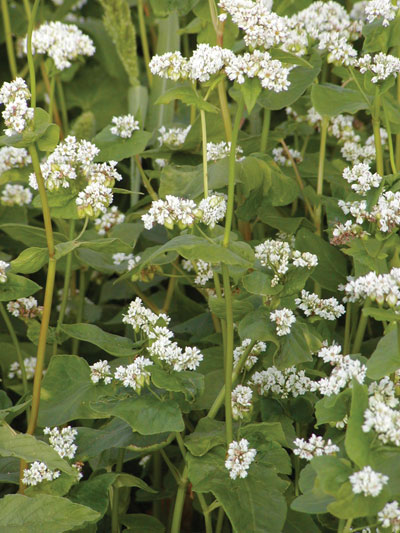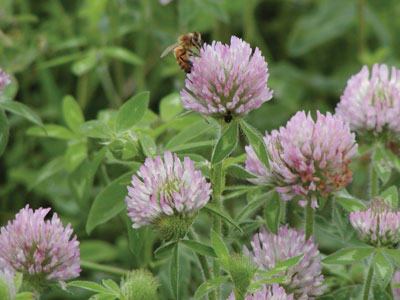
Features
Agronomy
Fertility and Nutrients
Green manure healthy for organic and conventional potatoes
Even though it is a dominant crop in eastern Canada, potatoes are grown on a limited land base and recent economic pressures have forced growers towards more intensive production with unfortunate consequences.
April 30, 2009 By Potatoes in Canada
 |
| Buckwheat is highly competitive and is noted for improving soil structure.
All photos courtesy of Dr. A. Hammermeister, OACC.
|
Even though it is a dominant crop in eastern Canada, potatoes are grown on a limited land base and recent economic pressures have forced growers towards more intensive production with unfortunate consequences. Soil degradation and nitrogen losses to the environment as a result of intense production mean alternate crops and production methods need to be introduced in order to maintain the viability of the production system. Researchers are suggesting that adding a green manure, a crop used primarily as a soil amendment and nutrient source for subsequent crops, in a rotation can increase nitrogen availability in the potato crops, improve yield and tuber quality, and improve the soil’s physical properties and suppress soilborne potato diseases.
Examined by the researchers as a nutrition source for organic potatoes, green manure also offers some benefits in conventional potato production. The issue that arises in organic production is how to get nutrients, especially nitrogen, to the crop while avoiding commercial fertilizer products. In conventional potato production, particularly in eastern Canada, having another crop in the rotation has many beneficial results besides the nutritional aspect. “Our work translates well to conventional production,” says Dr. Mehdi Sharifi, a researcher at the Organic Agriculture Centre of Canada (OACC) in Truro, Nova Scotia. However, the focus of the research done at OACC is to assist organic growers and those making the transition to organic production. “With conventional production, growers can supplement nutrition with commercial fertilizer, but in organic production, nitrogen has to be added through green manure or organic amendments, such as compost or manure.”
The essence of the work completed at the Centre suggests that growing green manure prior to potatoes will improve soil nutrient bio-availability, reduce the risk of nitrogen losses into the environment, and sustain or improve soil quality. The researchers also report that, by adding green manure into the rotation in an organic system, crop yields will be comparable to those attained under conventional cropping systems. “Green manure will build soil organic matter and provide nitrogen for the crop,” explains Dr. Andrew Hammermeister, OACC manager. “In our case, we had high background fertility, so the impact of the forages was not as obvious as we may have expected. Unfortunately, the forages also actually reduced potato yield to some extent, because soil conditions were too wet to allow for early spring ploughing and the sod from the green manure had not decomposed before potato planting. The latter resulted in poor seed bed condition. We also saw that including forage in the rotation may encourage wireworm populations to increase.”
Nevertheless, the researchers believe that under good conditions, the addition of green manure will benefit organic production and certainly assist in conventional production. “Green manure could work in conventional systems providing suitable timing for incorporation could be worked out,” Hammermeister continues. “Legume/forage plough downs can provide 30 to 100-plus kg/ha (27 to 89 lbs/ac) of nitrogen depending on the conditions.”
Adjustments may have to be made in order to begin reaping the benefits of green manure. In eastern Canada where two-year rotations are not uncommon, adding a forage into the rotation would move the rotation to three years, a plan encouraged by most researchers, but it would mean including another lower value crop in the rotation. Access to a livestock market would be ideal, but this is not always possible for every potato producer. In western Canada the options for including green manure in either conventional or organic systems are greater as markets are often more accessible. “We encourage conventional growers to move to three-year rotations because it will improve soil fertility and productivity, “ Sharifi says. “In organic rotations, growers need to have a four- or five- year rotation that might include another vegetable crop, such as carrots, and a cereal to help break up the disease cycle. With green manure, growers can sometimes get one or two cuts, if red clover is grown, which can be a profit generator.”
Sharifi says both intensive production systems deplete soil of organic matter causing potato yields to decline. Therefore, he says, growers need to consider green manure in order to maintain the sustainability of their production systems. In long-term research conducted in Maine, he says, “we replaced the cereal crop in the rotation with green manure and got good results, particularly with a white clover/bean/pea mix.” He adds: “The following year, in which potatoes were grown, significantly less nitrogen fertilizer for optimal yield was required.” In this case, the researchers believe the savings realized by reducing commercial fertilizer made up for the reduction in profit from the green manure compared to cereals in the previous year.
 |
| Red clover is a common forage legume used in rotations in Eastern Canada.
|
According to Hammermeister, in any system, green manures grown as annuals or forages can break up the disease and insect cycles, suppress weeds, provide soil nitrogen, build soil organic matter, increase availability of nutrients, such as phosphorus, and improve soil biology. He says that growers can adjust their production systems to include green manures by analyzing their operation. Selecting a green manure that suits the needs of the farm and its circumstances is the first step. “It helps to have a good plan for when and how to incorporate the forage or green manure, then plan to underseed a perennial forage as a green manure, such as alfalfa or red clover or, if you are growing a perennial legume crop, consider leaving at least one or two cuts in the year prior to potatoes to allow more buildup of organic matter and nitrogen,” he explains.
“Of course so much depends on the climate of where the potatoes are being grown,” adds Sharifi. “But, it is wise to move to green manure and reduce reliance on commercial fertilizer. By combining your high nutrient demanding potato crop with a less nutrient demanding crop and a green manure, your soils have a chance to recover. It’s not just the nutrient that you are getting, but also you are improving soil biological, chemical and physical conditions.”
Not without its concerns green manure can increase pressure from some diseases while minimizing pressure from others, it can also increase the nematode pressure. However, Hammermeister and Sharifi believe these are issues that can be managed and that the long term benefits outweigh the challenges. “Growers might be unwilling to include a green manure in their rotation because of the disease and nematode issues,” comments Sharifi, But, he adds, the benefits from adding green manure are much greater.
While the greatest value of adding green manure into a potato rotation may be recognized by organic growers, conventional growers will see benefits as well. The challenge lies in reorganizing the operation to include a green manure, such as moving to a longer rotation and finding a market for the forage if it is to be cut. While the researchers proved that sustainable crop production is possible with a combination of organic practices that include organic amendments and crop rotations with a green manure crop, conventional operations can benefit as well. In the long term, with the addition of a green manure crop into a conventional rotation, the legume nitrogen contribution to the subsequent potato crop can be taken into account in nitrogen recommendations to realize potential reductions in commercial fertilizer nitrogen requirements.